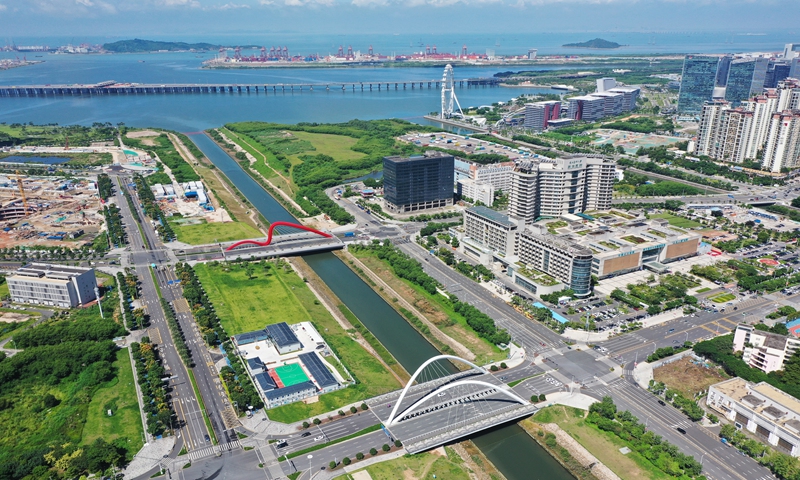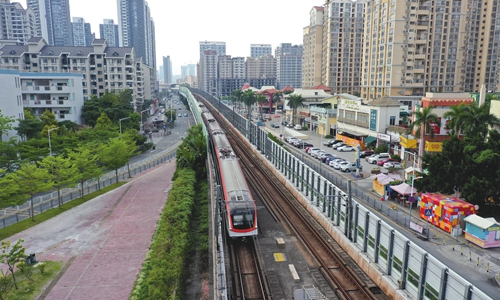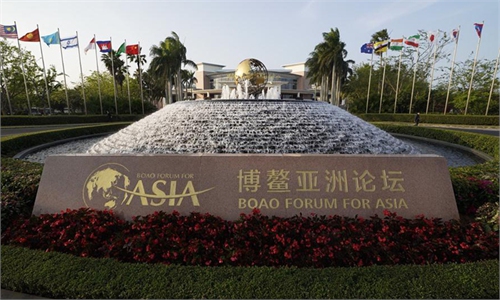Plan will deepen opening-up of Qianhai
Move seen to integrate Guangdong, HK and Macao closer

Qianhai Shenzhen-Hong Kong Modern Service Industry Cooperation Zone in South China's Guangdong Province Photo: VCG
One day after the Chinese government rolled out a plan to build a Guangdong-Macao cooperation zone in Hengqin island, it launched another program to deepen opening-up of the Qianhai Shenzhen-Hong Kong Modern Service Industry Cooperation Zone, a development zone located in Shenzhen that is known for opening-up policy experiments.
The concentrated rollout of development and opening-up plans for regions in the Guangdong-Hong Kong-Macao Greater Bay Area (GBA) shows the determination of the central government to further its opening-up reform, analysts told the Global Times on Monday.
According to a document released by the State Council, China's cabinet, the government will enhance the opening-up level of the Qianhai cooperation zone through multiple measures. First, the size of the cooperation zone will be expanded from 14.92 square kilometers to 120.56 square kilometers.
Second, a modern services industry development mechanism will be established that links Hong Kong and Macao, to be built with international standards. For example, officials will study the possibilities of pushing international ship registration and relevant systemic reforms, while pushing new industry models like internet plus and artificial intelligence (AI).
The government is taking measures to push cooperation of Shenzhen with Hong Kong and Macao via the Qianhai cooperation zone. For instance, it supports qualified Hong Kong, Macao and overseas professionals to take positions at statutory bodies located in the Qianhai zone, while supporting Qianhai to deepen regulation docking with Hong Kong and Macao in areas like services industry professional certificates, industrial management, supervision and others.
It also encourages the region to make experiments in financial reforms like connectivity with Hong Kong's financial markets, the yuan's cross-border usage, foreign currency usage and green finance cooperation.
The government's plan to enhance Qianhai's opening-up level was launched just a day after authorities issued a plan for building a Guangdong-Macao in-depth cooperation zone in Hengqin island in South China's Guangdong Province.
Like the plan for Qianhai, the Hengqin plan detailed measures that the government would take to increase the region's cooperation with Macao.
To name a few, the government is considering waiving tariffs on qualified goods entering the island, as well as encouraging the establishment of multi-currency investment funds in the region to develop a finance industry.
It is also mulling establishing a new port between the cooperation zone and the Hengqin campus under the University of Macao, so that students and faculty of the university can travel freely in and out of the cooperation zone.
The plans reflect the government's efforts to further stimulate cooperation among regions in the GBA, as the current level of economic interaction is not sufficient, experts said.
"The Greater Bay Area has reached a new development stage, new policies are needed to push such development," Deng Yu, senior analyst at the Bank of Communications, told the Global Times.
Thomas Yeung, vice dean of the Futian School of Finance, told the Global Times that Guangdong's cooperation with Hong Kong and Macao has not generated evident win-win results, which has pushed the government to search for a development plan that can bring mutual benefits to Guangdong/Hong Kong and Guangdong/Macao.
He said that through cooperation between Guangdong and Hong Kong/Macao, officials are eyeing an increased internationalization level of the Chinese mainland's markets, but are also fending off external economic and political attacks, as the government does not need to worry too much about risks like excessive loan defaults or housing speculation in Guangdong.
Experts also stressed that the development of Hengqin and Qianhai won't overlap with that of Macao or Hong Kong, but would stimulate the industrial layout in the GBA.
The Hengqin plan pointed out that the cooperation zone will focus on technology research and the development of advanced manufacturing industries, with input on specific industries such as integrated circuits, new materials, new energy, big data, AI and bioscience.
Lin Jiang, a professor of economics at Lingnan University College of Sun Yat-sen University, told the Global Times that although both Hengqin and the GBA stress a development focus on high-tech industries, which suggests overlapping, the area won't have vicious competition, but will offer their own advantages in cooperation.
For instance, Macao's financial sector doesn't have many advantages, and this generates more opportunities for financial firms in Hong Kong and Shenzhen. "Because of the good geographic condition of Hengqin, financial talent in Hong Kong and Shenzhen may access Macao's financial sector via the development zone," said Lin.
Lin believed that Hengqin can also participate in the development of various sectors including big data and AI, and realize diverse development.
"Hengqin and Qianhai can play an important role in restructuring the GBA region's high-tech industrial chains by means of financial and high-tech cooperation," he said.




